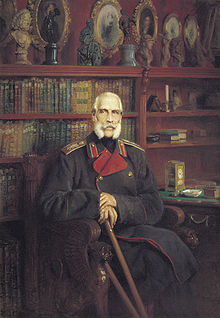- Stroganovs
-
For the food, see Beef Stroganoff.
The Stroganovs or Strogonovs (Russian: Строгановы, Строгоновы), also spelled in French manner as Stroganoffs, were a family of highly successful Russian merchants, industrialists, landowners, and statesmen of the 16th – 20th centuries who eventually earned nobility.
Contents
Origins
 Stroganovs' Nativity Church in Nizhny Novgorod
Stroganovs' Nativity Church in Nizhny Novgorod
The Stroganov family were originally rich Pomor peasants (i.e. from Russia's subarctic north, in the region of the White Sea). Feodor Lukich Stroganov, the progenitor of the family, settled in Solvychegodsk (also in the Russian north) in the late 15th century. Here, his son Anikey Fyodorovich Stroganov (1488–1570) opened the salterns in 1515, which would later become a huge industry. In 1558, Ivan the Terrible granted to Anikey Stroganov and his successors large estates in what was at the time the eastern edge of Russian settlement, along the Kama and Chusovaya Rivers
In 1566, at their own request their lands were included in the "oprichnina", the territory within Russia under the direct authority of Ivan the Terrible. Seizing lands from the local population by conquest and colonizing them with incoming Russian peasants, the Stroganovs developed farming, hunting, saltworks, fishing, and ore mining in these areas. They built towns and fortresses and, at the same time, suppressed local unrest with the help of a small private army (such private units were known as "druzhinas"), and annexed new lands in the Urals and Siberia in favor of Russia.
Semyon Anikeyevich Stroganov (? – 1609) and Anikey's grandsons Maksim Yakovlevich (? - 1620s) and Nikita Grigoriyevich (? – 1620) financed Yermak's Siberian campaign in 1581.
During the period of Polish intervention in the early 17th century, the Stroganovs offered humanitarian and military support to the Russian government (some 842,000 rubles just in terms of money), for which they received the title of distinguished people in 1610.
In the 17th century, the Stroganovs invested heavily in the salt industry in Solikamsk. In the 1680s, Grigory Dmitriyevich Stroganov (1656–1715) united all the scattered lands of the heirs of the children of Anikey Stroganov. He also annexed the saltworks, which belonged to the Shustov and Filatiyev families. In the 18th century, the Stroganovs established a number of ironworks and copper-smelting factories in the Urals.
A number of remarkable Baroque churches throughout Russia were built by the Stroganov family in the late 17th and early 18th century. They include the Cathedral of the Presentation of Mary (Введенский собор) in Solvychegodsk (1688–1696), Church of Our Lady of Kazan in Ustyuzhna (1694), Church of Our Lady of Smolensk (церковь Смоленской Богоматери) in Gordeyevka (part of today's Kanavino district of Nizhny Novgorod) (1697), and the Nativity Church in Nizhny Novgorod (started in 1697, consecrated in 1719).[1]
Barons Stroganov
 Sergei Grigorievich Stroganov by Konstantin Makovsky, 1881
Sergei Grigorievich Stroganov by Konstantin Makovsky, 1881
During the Great Northern War of 1700–1721, the Stroganovs rendered sizable financial support to the government of Peter the Great, for which Alexander Grigoriyevich, Nikolay Grigoriyevich, and Sergei Grigoriyevich would be raised to the rank of baron in 1722 and later to that of count.
From then on, the Stroganovs were members of the Russian aristocracy and held important government posts.
- Sergei Grigoriyevich (1707–1756) played a significant role during the reign of Elizabeth Petrovna.
- His son Alexander Sergeyevich (1733–1811) was a member of the commission on elaborating the new code of laws during the reign of Catherine the Great. In the late 18th – early 19th century, he held different posts, such as president of the Russian Academy of Arts, art director of the Public Library, and member of the State Council.
- Pavel Alexandrovich Stroganov (1772–1817) was a member of the Private Committee (Негласный комитет) of Alexander I and assistant to the minister of the interior.
- Sergei Grigoriyevich Stroganov (1794–1882) was the governor general of Moscow in 1859–1860. He founded Stroganov Moscow Arts and Industrial Institute in 1825.
- Alexander Grigoriyevich Stroganov was the minister of the interior in 1839–1841 and then a member of the State Council (since 1849).
Most of the Stroganovs are known to have shown interest for art, literature, history, and archaeology. They used to own rich libraries, collections of paintings, coins, medals etc. Stroganov Palace (now one of the buildings of the State Russian Museum) is among the chief sights of Nevsky Prospekt in Saint Petersburg.
Modern times
After the Russian Revolution of 1917 the Stroganov family emigrated with the White movement and all family property in Russia was nationalized.
Created in 1992 in the State of New York as a not-for-profit corporation The Stroganoff Foundation is dedicated to conservation and restoration of the Russian heritage of the Stroganoff family. The establishment of the Stroganoff Foundation was the inspiration of Baroness Hélène de Ludinghausen, who lives in Paris and whose mother, Princess Xenia Alexandrovna Shcherbatova-Stroganova, was born in the Stroganoff Palace.
See also
- Beef Stroganoff is thought to have been named after the family
- Stroganov School of icon painting
- Genealogy of the family
References
- ^ V.F.Kosushkin. Restoring the icons in the iconostasis of the Nativity (Stroganov) Church in Nizhny Novgorod (В.Ф. Косушкин. Реставрация икон в иконостасе Рождественской (Строгановской) церкви в Нижнем Новгороде)
Further reading
- Noveishii putevoditel po Stroganovskomu dvorcu. Ed. S. Kuznetsov. SPb.: B. S. K., 1995. - 77 p. - ISBN 5-88925-001-9
- Kuznetsov S. Dvorcy Stroganovych. SPb., Almaz, 1998. - 160 p.
- Kuznetsov S. Pust Francia pouchit nas "tancovat". Sozdanie Strogonovskogo dvorca v Peterburge i svoeobrazie pridvornoi kultury Rossii v pervoi polovine XVIII veka. SPb., 2003. - 512 p. - ISBN 5 - 3-3-0010901
- Kuznetsov S. Ne chuze Tomona. Gosudarstvennaya, mecenatskay< sobiratelskaya deaitelnost roda Strogonovych v 1771-1817 gg. i formirovanie imperskogo oblika S.-Peterburga. Spb.: Nestor, 2006. - 447 p. ISBN 5-303-00293-4
- Kuznetsov S. Dvorcy i doma Strogonovych. Tri veka istorii. SPb.: 2008. - 318 p. - ISBN 978-5-9524-3471-4
Categories:- Stroganov family
- Russian noble families
Wikimedia Foundation. 2010.
